Another week of birdwatching classes saw us in St Andrews (2x), Rendall (2x) and Sandwick. The Rendall classes met up with Barnacle Geese, Golden Plovers and Red Grouse, the St Andrews classes met up with Great Northern Divers, Velvet Scoters, Bar-tailed Godwits and Knot while the Sandwick class saw Whooper Swans, Shelducks, Shovelers, Barnacle Geese and Pink-footed Geese. The geese and swans are just in the last throes of taking energy on board before heading off to Iceland - probably within the next ten days.
It's almost possible to see the flowers growing - certainly it is with the rhubarb in our garden - it's shot up 20" in 14 days. Along a couple of the lanes in Puldrite, Rendall the Lesser Celandines were like chrome stars on the sides of the verges and ditches, and even more so six days later along the track to the Hall of Tankerness.
Bacon Tub, Rerwick
Our St Andrews walk took us around the spectacular Rerwick coast which is peppered with geos, wave-cut platforms, arches, stacks and even a couple of gloups. Fulmars, Shags, Black Guillemots and Ravens were all either nesting or beginning to nest on cliffs that were dressed with the succulent dark green leaves of Scurvy Grass. Also evident, but only on the south facing sheltered cliffs were the first signs of Scots Lovage a plant exclusively confined in Britain to Scotland and Northern Ireland.
newly emerging Scots Lovage at Rerwick
In Orkney Scots Lovage can be found on cliffs but may also be found growing low down on shingle and sandy shores. Some conveniently grows along the Churchill barriers. You can see it quite easily at No4 barrier, the Burray end.
The finished article
















